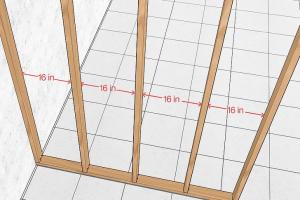Step-by-Step Guide to Building a Fake Wall for Your Space

-
Quick Links:
- Introduction
- Why Build a Fake Wall?
- Materials and Tools Needed
- Step-by-Step Guide to Building a Fake Wall
- Design Ideas for Fake Walls
- Case Studies
- Expert Insights
- FAQs
Introduction
Building a fake wall can be an ingenious solution for various home improvement projects. Whether you're looking to create more privacy, define spaces within a room, or even disguise unsightly features, a fake wall can be an effective and stylish choice. In this comprehensive guide, we'll take you through everything you need to know about constructing a fake wall, from materials to installation.
Why Build a Fake Wall?
Fake walls serve numerous purposes that can enhance both the functionality and aesthetics of your living space. Here are some compelling reasons to consider building one:
- Space Division: Fake walls can help create distinct areas in open-plan living spaces.
- Soundproofing: Adding a fake wall can reduce noise between rooms.
- Decorative Elements: They provide a surface for art, shelving, or other design elements.
- Concealment: Fake walls can hide wiring or plumbing, creating a more polished look.
Materials and Tools Needed
Before diving into the construction process, gather the following materials and tools:
Materials
- Drywall or plywood sheets
- Studs (wood or metal)
- Screws and anchors
- Joint compound and tape
- Paint or wallpaper (for finishing)
- Soundproofing materials (if needed)
Tools
- Measuring tape
- Level
- Drill
- Utility knife
- Saw (hand saw or circular saw)
- Paintbrush and roller
Step-by-Step Guide to Building a Fake Wall
Now that you have everything you need, follow these steps to build your fake wall:
Step 1: Plan Your Layout
Measure the area where you want to build the wall. Use a pencil to mark the spots for the studs and the wall outline on the floor and ceiling.
Step 2: Install the Bottom Plate
Secure a bottom plate (a horizontal piece of wood) to the floor where the wall will go. Make sure it's straight using a level.
Step 3: Add Vertical Studs
Cut your studs to the desired height and attach them vertically to the bottom plate, spaced 16 inches apart. Secure them to the ceiling using screws or anchors.
Step 4: Install the Top Plate
Once the studs are secured, add a top plate to connect the tops of the vertical studs.
Step 5: Attach Drywall or Plywood
Cut the drywall or plywood to size and attach it to the frame with screws.
Step 6: Finish the Surface
Use joint compound to fill any seams and screw holes. Once dry, sand the surface smooth and paint or wallpaper as desired.
Step 7: Enhance Soundproofing (Optional)
If soundproofing is a goal, add insulation between the studs before attaching the drywall.
Design Ideas for Fake Walls
To make your fake wall more aesthetically pleasing, consider these design options:
- Accent Walls: Paint one side a bold color or apply wallpaper for a striking effect.
- Shelving: Incorporate built-in shelves for books or decorative items.
- Art Display: Use the wall to hang artwork or photos, creating a gallery feel.
Case Studies
Let's look at a few real-world examples where fake walls have been successfully implemented:
Case Study 1: Residential Open-Concept Living Room
A homeowner in a small apartment used a fake wall to separate the living area from the bedroom, creating a cozy nook that enhances privacy and style.
Case Study 2: Office Space Redesign
An office utilized a fake wall to create meeting rooms within an open workspace, improving sound privacy and functionality.
Expert Insights
Experts suggest considering the following tips when building a fake wall:
- Always double-check your measurements before cutting materials.
- Consider the weight of materials when choosing what to use.
- Engaging a professional for complicated designs can save time and ensure quality.
FAQs
1. What materials are best for a fake wall?
Drywall is commonly used for its affordability and ease of installation, while plywood provides a more rustic look.
2. How much does it cost to build a fake wall?
The cost varies based on materials and size, but you can expect to spend between $200 to $800.
3. Can I install a fake wall myself?
Yes, with some basic tools and skills, many homeowners can successfully build a fake wall.
4. Is it possible to soundproof a fake wall?
Yes, adding soundproofing insulation between the studs can significantly reduce noise transmission.
5. Do I need a permit to build a fake wall?
Check local building codes, as some areas may require permits for structural changes.
6. Can fake walls be removed easily?
Yes, if constructed properly, fake walls can be dismantled without major damage to the surrounding area.
7. What is the best way to finish a fake wall?
Painting or applying wallpaper are popular options, but you could also use decorative panels.
8. How long does it take to build a fake wall?
The process can take anywhere from a few hours to a couple of days, depending on your experience and the complexity of the design.
9. Can I use a fake wall to create a storage area?
Absolutely! You can design the wall to include built-in storage solutions.
10. What tools do I need for a DIY fake wall?
Basic tools include a measuring tape, level, drill, saw, and utility knife.
Random Reads
- How to spot a spy
- How to split pdf files
- How to solder wires electronics
- How to video call between android and iphone
- How to turn on lg phone
- How to save streaming video
- How to scan and print pictures from a computer
- Simple techniques create clouds photoshop
- How to make a cake in minecraft
- How to make a ceiling look higher